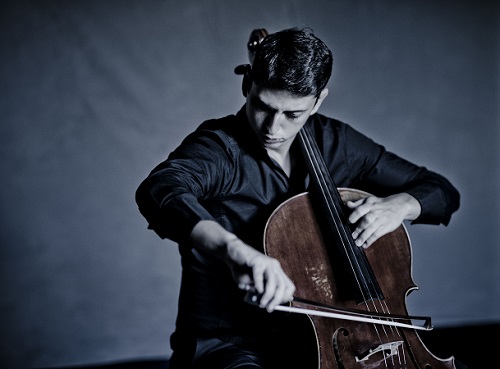 United Kingdom Beethoven, Schumann, Chopin, Grieg: Narek Hakhnazaryan (cello), Pavel Kolesnikov (piano), Wigmore Hall, London, 25.5.2019. (CS)
United Kingdom Beethoven, Schumann, Chopin, Grieg: Narek Hakhnazaryan (cello), Pavel Kolesnikov (piano), Wigmore Hall, London, 25.5.2019. (CS)

Beethoven – 7 Variations on ‘Bei Männern, welche Liebe fühlen’ from Mozart’s Die Zauberflöte WoO.46; Cello Sonata in A Op.69
Schumann – Fantasiestücke Op.73; Kinderszenen Op.15 No.7, Träumerei
Chopin – Introduction and Polonaise brillante in C Op.3; Étude in C sharp minor Op.25 No.7
Grieg – Cello Sonata in A minor Op.36
There are some concerts where the performers and audience alike seem to want the music to go on forever, the stream of luxuriant sound pouring forth effortlessly and infinitely. Such was this recital by cellist Narek Hakhnazaryan and pianist Pavel Kolesnikov at the Wigmore Hall.
Since the Armenian cellist won the Cello First Prize and Gold Medal at the XIV International Tchaikovsky Competition in 2011 at the age of 22, he has stepped up to the forefront of the world stage, performing with major orchestras and at prestigious venues, to universal acclaim. On the evidence of this recital, he doesn’t ‘merely’ have an impeccable technique, beautifully soulful tone and interpretative insight and imagination; so easefully and naturally does the song pour from his 1707 Joseph Guarneri instrument, that it seems that Hakhnazaryan literally breathes music. Paradoxically, just as the lyricism seems to come from deep within him, so he ‘lives’ the music. Not in an excessively demonstrative manner, though; indeed, his concert demeanour is self-possessed and focused, the passion expressed through the music and not through gesture.
Hakhnazaryan’s tone is ineffably sweet but not ‘juicy’; though his vibrato is broad and expressive, the tone is itself quite lean and focused. It shines with light and colour. It’s a big sound, too. Pavel Kolesnikov played with great sensitivity and thoughtfulness throughout the recital, displaying an enormous variety of colour, dynamic range and nuance, but even when the Steinway surged with a Romantic roar Hakhnazaryan’s cello was its equal for presence and power.
The repertoire presented was perfect for its purpose, the feast of mid-nineteenth-century Romantic riches evidently giving Hakhnazaryan and Kolesnikov as much pleasure as it gave the Wigmore Hall audience. Some of the items are perhaps more commonly heard as encores. Chopin’s Introduction and Polonaise brillante in C is quite a showpiece, even more so for the piano than for the cellist, but the techniques of neither Hakhnazaryan nor Kolesnikov seemed at all tested here. Moreover, despite Chopin’s dismissal of the piece – ‘Nothing to it but dazzle, for the salon, for the ladies’ – and the brilliance of the piano’s flourishes, here the breezy energy was matched by expressive clarity. There was even greater expressive nuance in the C#-minor Étude (as transcribed by Auguste Franchomme): Kolesnikov may have had to relinquish his left-hand melody to the cellist, but his sensitive repeating quavers at the start, dreamy evocativeness and refined rubato enhanced, not simply accompanied, Hakhnazaryan’s soulful melodising.
In Schumann’s ‘Träumerei’ from Kinderszenen, the cello’s own dreaminess in no way diminished the refined definition of the melodic line. Here, Hakhnazaryan’s bow seemed a seamless extension of his arm, the latter a kinetic embodiment of his musical understanding and feeling. In contrast, the three short Fantasiestücke Op.73, written in just over two days in February 1849, were full of unrest and changefulness, shifting unexpectedly from introspection to fieriness.
More substantial Romantic masterpieces framed these eloquent ‘miniatures’. The recital began with Beethoven’s 7 Variations on ‘Bei Männern, welche Liebe fühlen’ from Die Zauberflöte: charming and playful, Hakhnazaryan and Kolesnikov offered us the warm, consoling certainties expressed by Pamina and Papageno as they extol the sacredness and security of marital love. There was excellent balance as cello and piano engaged in conversation, Kolesnikov finding a lovely transparency of texture. When the cello line roved low, the sonorous richness of Hakhnazaryan’s C string found a perfect partner in the piano’s strong bass line.
More happiness was to be found in Beethoven’s A major Cello Sonata Op.69, in which the lyricism scarcely pauses for breath, melodies unfolding in a ceaseless fount of warmth and joy. Hakhnazaryan relished the long expansive lines though never wallowed in the tunefulness. Indeed, in the first movement there was a hint of impetuosity and the cello’s vigorous passagework had muscularity and precision. Moreover, there was balance: the players knew when to take the lead, when to sit back, and when to sing in partnership. It was clear that the performers had the measure of the work’s architecture. High spirits were tempered by repose, and overall the performance epitomised middle-period Beethoven: confident, clear-sighted and full of joy.
And, finally, we had Grieg’s Cello Sonata in A minor. It’s a long, dense work, bursting with folk-inspired melodies. It’s also often denigrated as ‘repetitive’, but Hakhnazaryan and Kolesnikov played with such passionate intensity and commitment that the repetitions of the main theme in the Allegro agitato were searching and flowing, the utterances strong, the elaborations daring, with calm provided by a dreamy second subject which, as Hakhnazaryan’s vibrato relaxed, seemed to conjure Norwegian vistas. There was unwavering forward momentum in the closing stages, though the climaxes were never hyperbolic – despite Grieg’s markings: fff, pesante and crescendo! – and the playing was flawlessly accurate. The shifts in mood in the Andante molto tranquillo were persuasive; the drama of the Allegro molto e marcato never lapsed into bombast. I think what made the performance so compelling was the fact that while the partnership between the musicians was consummate, they allowed each other freedom: such confidence seemed to infuse into the music itself, which soared around the Wigmore Hall with tonal beauty and strength.
Hakhnazaryan and Kolesnikov were never going to be allowed to ‘leave it at that’, and although they’d already offered substantial musical fare, we had two encores, the last of which – Rachmaninov’s Vocalise – was wonderfully cleansing and restorative, after an evening of vigour, drama and, above all, heartfelt melody.
Claire Seymour